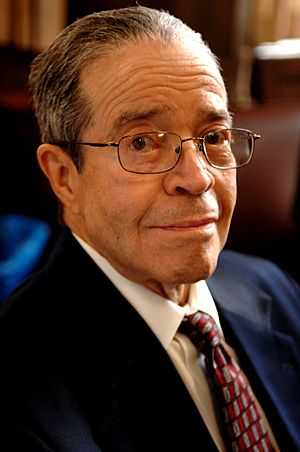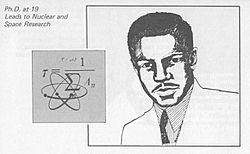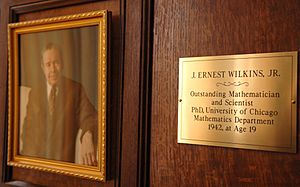J. Ernest Wilkins Jr. facts for kids
Quick facts for kids
J. Ernest Wilkins Jr.
|
|
|---|---|

Wilkins in 2007
|
|
| Born | November 27, 1923 Chicago, Illinois, U.S.
|
| Died | May 1, 2011 (aged 87) Fountain Hills, Arizona, U.S.
|
| Alma mater | University of Chicago |
| Known for | Work on nuclear physics and engineering |
| Scientific career | |
| Fields | Mathematics and physics |
| Institutions | Metallurgical Laboratory Argonne National Laboratory |
| Influences | J. Ernest Wilkins Sr. Arthur Holly Compton Enrico Fermi |
Jesse Ernest Wilkins Jr. (November 27, 1923 – May 1, 2011) was an African American nuclear scientist, mechanical engineer and mathematician. A child prodigy, he attended the University of Chicago at the age of 13, becoming its youngest ever student. His graduation at a young age resulted in him being hailed as "the Negro Genius" in the national media.
Wilkins and Eugene Wigner co-developed the Wigner-Wilkins approach for estimating the distribution of neutron energies within nuclear reactors, which is the basis for how all nuclear reactors are designed. Wilkins later went on to become the President of the American Nuclear Society in 1974.
Wilkins had a widely varied career, spanning seven decades and including significant contributions to pure and applied mathematics, civil and nuclear engineering, and optics. Wilkins was one of the African American scientists and technicians on the Manhattan Project during the Second World War. He also conducted nuclear physics research in both academia and industry. He wrote numerous scientific papers, served in various important posts, earned several significant awards and helped recruit minority students into the sciences. During his life he was often the target of racism.
Contents
Education and early career
In 1940, Wilkins completed his AB in mathematics at the University of Chicago. He went on to an MS and PhD in mathematics at the same institution, which he completed in 1941 and 1942.
Having initially been unable to secure a research position, Wilkins taught mathematics from 1943 to 1944 at the Tuskegee Institute (now Tuskegee University) in Tuskegee, Alabama.
Manhattan Project
In 1944 he returned to the University of Chicago where he served first as an associate mathematical physicist and then as a physicist in its Metallurgical Laboratory, as part of the Manhattan Project. Working under the direction of Arthur Holly Compton and Enrico Fermi, Wilkins researched the extraction of fissionable nuclear materials, but was not told of the research group's ultimate goal until after the atomic bomb was dropped on Hiroshima. Wilkins was the co-discoverer or discoverer of a number of phenomena in physics such as the Wilkins effect and the Wigner–Wilkins spectra.
When Wilkins's team was about to be transferred to the Oak Ridge National Laboratory in Oak Ridge, Tennessee (known at the time as site "X"), due to the Jim Crow laws of the Southern United States, Wilkins would have been prevented from working there. When Edward Teller was informed about this, he wrote a letter on September 18, 1944, to Harold Urey (who was the director of war research at Columbia at the time) of Wilkins's abilities, informing him about the issue caused by local reactions to Wilkins's race, and recommending his services for a new position. As Teller explained:
Knowing that men of high qualifications are scarce these days, I thought that it might be useful that I suggest a capable person for this job. Mr. Wilkins in Wigner's group at the Metallurgical Laboratory has been doing, according to Wigner, excellent work. He is a colored man and since Wigner's group is moving to "X" it is not possible for him to continue work with that group. I think that it might be a good idea to secure his services for our work.
Wilkins then continued to teach mathematics and conduct significant research in neutron absorption with physicist Eugene Wigner, including the development of its mathematical models. He would also later help design and develop nuclear reactors for electrical power generation, becoming part owner of one such company.
Later career
To improve communication between mathematicians and nuclear engineers on a project, Wilkins earned bachelor's (1957) and master's degrees (1960) in mechanical engineering from New York University, thus earning five science degrees during his life. It also qualified him to design and build nuclear facilities.
In 1970 Wilkins went on to serve Howard University as its distinguished professor of applied mathematical physics and also to help found the university's PhD program in mathematics. During his tenure at Howard he undertook a sabbatical position as a visiting scientist at Argonne National Laboratory from 1976 to 1977.
From 1974 to 1975 Wilkins served as president of the American Nuclear Society and in 1976 became the second African American to be elected to the National Academy of Engineering.
From 1990 Wilkins lived and worked in Atlanta, Georgia as a distinguished professor of applied mathematics and mathematical physics at Clark Atlanta University, and retired again for his last time in 2003.
Throughout his years of research Wilkins published more than 100 papers on a variety of subjects, including differential geometry, linear differential equations, integrals, nuclear engineering, gamma radiation shielding and optics, garnering numerous professional and scientific awards along the way.
Family
Wilkins had two children with his first wife Gloria Louise Steward (d.1980) whom he married in June 1947, married Maxine G. Malone in 1984. He was married a third time to Vera Wood Anderson in Chicago in September 2003. He had a daughter, Sharon, and a son, J. Ernest III, during his first marriage.
His father, J. Ernest Wilkins Sr., served as US Assistant Secretary of Labor during the Eisenhower administration.
Wilkins is the uncle of two notable attorneys: David B. Wilkins, a professor at the Harvard Law School, and Timothy A. Wilkins, a partner with Freshfields Bruckhaus Deringer.
Wilkins died on May 1, 2011 in Fountain Hills, Arizona. He was buried at the National Memorial Cemetery, Cave Creek, Arizona on May 5.
Tributes and honors
- The Wilkins effect, plus the Wigner–Wilkins and Wilkins spectra, discovered during the 1940s, are named or co-named after him;
- In March 2007 Wilkins was honored by his alma mater, the University of Chicago, in a special ceremony that included the dedication of his portrait and a plaque in the Eckhart Hall Tea Room of its Physical Sciences Division;
- U.S. Army Outstanding Civilian Service Medal, 1980;
- NAM, Honorary Life Member, Lifetime Achievement Award, 1994;
- QEM Network, Giant in Science Award, 1994;
- Department of Energy, Special Recognition Award, 1996;
- University of Chicago Alumni Association, Professional Achievement Citation, 1997.
Memberships
Some of Wilkins's memberships included:
- Kappa Alpha Psi fraternity 1938
- National Academy of Engineering, Member, elected in 1976;
- American Society of Mechanical Engineers;
- American Nuclear Society, Board of Directors, 1967–77, President, 1974–75;
- National Research Council of the United States, Advisory Committee on Reactor Safeguards, Chairman, 1990–94;
- Oak Ridge Associated Universities, council, 1990;
- U.S. Army Science Board, chairman, 1970–2001.
See also
- List of African-American inventors and scientists
- J. Ernest Wilkins Sr., Wilkins' father and the first African American to participate in White House cabinet-level meetings



